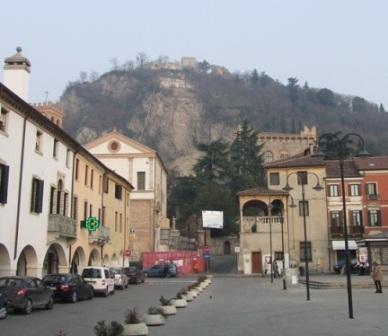About Monselice
Monselice is a picturesque little town in the north-eastern Veneto region of Italy. It is located at the edge of the Euganean Hills (Colli Euganei) in the Province of Padua (Padova). Since the town is strategically clustered around an easily-defendable hill, its origins go back a long way. Monselice is an attractive historic destination for a short daytrip or a stop on a tour of this pleasant area of Italy. Monselice is pronounced with the stress on the second syllable: MonSELeechay.
Archaeology has discovered evidence of settlement here in the Bronze Age and earlier, and there was a Roman town on the site, but Monselice’s most important incarnation began under the Lombards and Franks, when it was a stronghold ruling over a large area. After a spell as a medieval city-state, the town was conquered in the thirteenth-century by Ezzelino III da Romano who ruled under the Holy Roman Emperor Frederick II. Monselice’s next rulers were the Carrara family from Padua, before the town was taken by the Venetians. In the eighteenth century they used trachyte stone from the hills here to pave St. Mark’s Square in Venice.
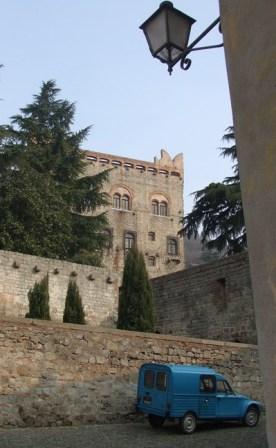
Modern Monselice sprawls somewhat over the surrounding plain, and there is a faint rumble of traffic passing on the busy roads nearby, but the heart of town is still full of historical atmosphere. It’s easy to spend a pleasant couple of hours wandering around the cobbled lanes and seeing the principal buildings of the town, and this makes a good peaceful daytrip from busier destinations like nearby Padua.
Find and book hotels. With location maps and guest reviews.
Things to see
Monselice has two different castles to offer the visitor. The Rocca is the older of the two, the ruined fortress on a hilltop which is the town’s most recognisable landmark. There is also a later and more palatial castle at the foot of the hill which is open to the public and has starred on the screen.
If you are arriving by train it’s easy to find your way; the ruined fortress on the town’s little hill (the Rocca) is clearly visible and you head towards it. There is also a large map on a board outside the station. After crossing the Canale Bisatto, turn back to see Villa Pisani, an attractive Palladian building. On the right is a stretch of Monselice’s defensive town wall. Here you can either walk along the canal to the right, then take a left turn, or continue ahead and then turn right to reach the town’s principal square, Piazza Mazzini. This is a large open space with views up to the Rocca. It contains the Torre Civica, a clocktower, and the Biblioteca Comunale, formerly the Monte di Pietà (pawnbroker’s), which has a charming loggia (and is alongside the tourist information office). The former church of San Paolo has been adapted as an exhibition space; inside you can see fragments of fresco and the exposed foundations of an earlier Romanesque church.
Just a few yards uphill along Via del Santuario is the entrance to the Castello di Monselice, the second of the town’s castles. This complex of buildings dates back, in part, to the eleventh century and later became the stronghold of Ezzelino da Romano. It was converted into a less warlike residence by the Venetian Marcello family and is also known, after them, as Ca’ Marcello. The Castello is open to the public and can be visited on guided tours at set times of the day between April and November (see our links below for the official website with latest opening times). There is an admission charge. Inside the castle is the Museo Antiquarium Longobardo which contains Lombard artefacts found nearby.
The Castello di Monselice played a starring role in the TV series A Discovery of Witches, adapted from the vampires-and-academics All Souls Trilogy by Deborah Harkness.
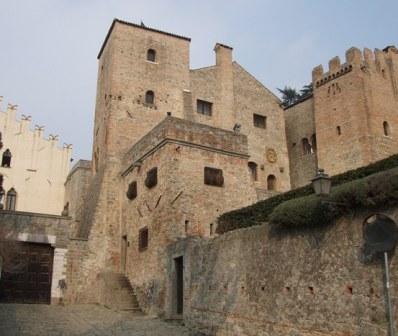
Continuing along Via del Santuario the next sight is Villa Nani Mocenigo, a sixteenth-century villa. It is private property, but tourists can admire the dwarf statues along the wall (a reference to the name of the first owners; nani means dwarves) and peer through the gate at the elegant garden stairway. The lane continues uphill to the Pieve di Santa Giustina, also known as the Duomo Vecchio (Old Cathedral). This is a late Romanesque church which is worth entering (when open) to see the artworks inside. It too is closed in winter.
Just past the church is a small panoramic spot with benches. Alongside is the Porta Romana, a gateway guarded by two large stone lions on columns. The lane beyond is both the approach to an elegant villa and a pilgrimage route. The Duodo family who owned the building (called, naturally, Villa Duodo) erected a series of chapels along the route, the Sette Chiese. The earliest part of the villa, the wing on the right, was designed by architect Vincenzo Scamozzi. Next to the villa, perched above the slope, is a small chapel dedicated to St. George, San Giorgio. Inside are some damp-damaged frescoes, and, beyond the central altar, a kind of display cabinet containing – behind glass windows – the dressed-up relics of early Christians, removed from the catacombs of Rome. The macabre display gives pride of place to a martyr optimistically identified as San Valentino (St. Valentine). A special ceremony is held here on his saint’s day, February 14th, when children are given small golden keys to ward off epilepsy. The villa is not open to the public, although you can climb the stone amphitheatre above, another religious shrine, and admire the statues on the building’s facade.
Alongside the stone amphitheatre of Villa Duodo a flight of steps climbs uphill towards the Rocca, the hill topped by Frederick II’s keep, the Mastio Federiciano. At the time of my first visit to Monselice there was a lot of local controversy over the development of this site (expensive plans including a lift and access tower). More recently the hill has been open (with limited times) to the public, generally on guided archaeological-and-nature tours. It’s an atmospheric climb and worth doing if you visit when open.
Returning downhill as far as Santa Giustina, you can take a steep alley on the left, Vicolo Scalone, to descend to the main part of Monselice. By this point you’ve seen Monselice’s main attractions, but the medieval lanes below are pleasant to wander and explore on your way back towards Piazza Mazzini. Towards the foot of the alley there are some weathered communist carvings in the paving slabs, dated 1951.
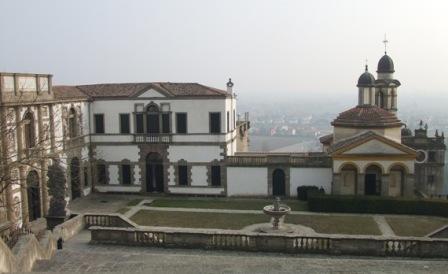
Along the road to the right, Via Carboni, is one of Monselice’s grander buildings, Ca’ Bertana, an elegant town-house. Following the lanes back around to the pedestrianised heart of town, you pass a couple of buildings which are sadly (or perhaps romantically) decayed: the Chiesa di Santo Stefano and a grand fifteenth-century house, Ca’ Paradisi-Capodivacca. Although the latter was being restored when I visited, the large church stood apparently abandoned and crumbling.
If you want a different perspective on Monselice, and you’re spending more than a couple of hours here, you could try walking up the hill opposite town, Monte Ricco. From a starting point by the railway station you can ascend to a monastery or follow a path which circles the summit. Although many of the slopes have been eaten away by quarrying, the views over Monselice and the Euganean Hills and the remaining woodland are attractive. Further directions are available from the tourist information office.
Eating, planning and practicalities
Monselice is best visited between April and November, when the town’s attractions are most likely to be open. The town’s tourist information centre is in Piazza Mazzini, with its entrance on the lane that leads up to the Castello. They stock information about the town, surrounding area and Padua, and also have a lovely model of the town. Like the town’s attractions, the office closes for a couple of hours at lunchtime.
Around the historic area there aren’t many places to eat or drink, but you’ll find a handful of bars which serve sandwiches and rolls around the pedestrianised lanes and in Piazza San Marco. There is a restaurant in Piazza Mazzini and a bar opposite the castle.
On the second and third weekends in September Monselice holds a colourful re-enactment event called the Giostra della Rocca – the Joust at the Citadel, with events such as a palio, a human game of chess, a medieval market and a costumed procession.
Travel to Monselice
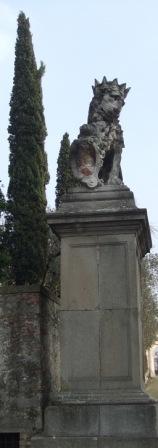
Monselice is on the regional railway line which connects Venice and Padua with Ferrara and Bologna, and it can be visited easily as a daytrip from these cities. Fares are cheap – a one-way ticket from Venice costs under 4 at the time of writing, and the journey takes an hour. Another railway line connects Monselice with nearby Este and with Mantua (Mantova).
Things to do around Monselice
The Colli Euganei area is dotted with interesting small towns and villages like nearby Este, original seat of the Este dynasty. The two towns can easily be combined in a daytrip. The biggest tourist destination around the hills is spa resort Abano Terme. Padua is just a short train ride away. This area has put a big effort into marketing itself to tourists, and the local tourist information offices stock lots of useful information in English, including directions and maps of walks around the hills.
Where to stay
There is one good affordable accommodation option in Monselice, the Venetian Hostel. It is based in a lovely restored old building, and since it belongs to the town (comune) it is helpfully included on all the tourist signposts. Although called a hostel, you can book private rooms.
> Venetian Hostel, Monselice – read more and make a booking
They don’t have the same historic atmosphere, but Abano Terme and its neighbour Montegrotto Terme both have a large choice of hotels and are only a few miles away. The city of Padua is also conveniently close.
> Accommodation in and around Monselice
On this site
Useful external links
Veneto destinations
- Veneto region
- Abano Terme
- Asolo
- Bassano del Grappa
- Brenta Canal
- Caorle
- Castelfranco Veneto
- Chioggia
- Cittadella
- Concordia Sagittaria
- Conegliano
- Cortina d’Ampezzo
- Lido di Jesolo
- Malcesine
- Marostica
- Monselice
- Montegrotto Terme
- Padua
- Portogruaro
- Rovigo
- Sottomarina
- Treviso
- Venetian Lagoon
- Venice
- Verona
- Vicenza
- Veneto art & architecture itinerary
- Veneto villas – Vicenza: La Rotonda & Villa Valmarana ai Nani
- Veneto villas – Villa Pisani & Villa Foscarini Rossi, Strà
- Venice Airport
- Treviso Airport
